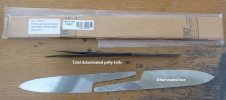Willie,
Your assumption is correct. - I will elaborate.
Lets talk about why people think Japanese steel is superb and why the Hitachi steels have the reputation that they are the best of the best.
In the early days of sword and knife making, various metals emerged to make the sharp rocks, sticks, and bones obsolete. Copper, bronze, and iron were all high tech weaponry in their day.
Then someone smelting iron noticed that the bloom had chunks that were harder. They did not understand what a carbon-iron diagram was, but they knew hard when they saw it. Over centuries, different ways to smelt out the iron and add the carbon were developed. Because they had no idea what any changes caused, the process became a nearly magical/religiousritual that was both protected as well as adhered to and taught by rote. The Two of the most famous today were the Japanese with their tartara blooms called tamahagane, and the Indians with their wootz. Both were different because they came about through different development processes, and both were similar in they were kept secret and promoted with legends and stories of magical properties.
The Japanese steel was sorted from the bloom by a very experienced (old) smith who would determine how "hard" the pieces were. A blend of this was mixed and welded into a bar of solid steel. It wads very irregular as to carbon content, varying from cast iron to soft iron. The bar was folded and folded to evenly distribute the carbon, ending in the tamahagane of samurai sword legend. These billets were often very high carbon content ..... some being well over 2%. The quality of the billet was a factor of the smith who made it. Those with name recognition and imperial status were accepted as the best sources. Yasuki steel district near Edo (Tokyo) was the accepted source of the best steel, mainly due to its location/access to the main markets and the Emperor. Steel from here became known as Yasuki Hagane - literally, "Blade Steel from the Bay Area". Fast forward to today when the grain boundaries and carbide distribution are subjects of relatively inexperienced smiths. The foundries with their PhD metallurgists can make a bar of steel any way they want...every time. The steel giant, Hitachi, used the Yasuki label to their advantage to make its steel stand out among all others as the top grade. The use of Hitachi #1 white is a standard for top grade Japanese blades. The buyers want to see that Yasuki/Hitachi name to know it is a good knife. Today, the same knife made from Aldo's W2, or any high carbon steel from Sandvik, Uddeholm, Niagara, etc. will be just as good. For well over 30 years, it is all marketing. Compare this to Rolex, who markets its name as meaning superior quality ( which it is definitely not).
Back to the tamahagane steel.
The billet was given/sold to a smith who would forge the basic shape, and given/sold to a smith who would harden it, and given/sold to a togishi who would make it a sharpsword, and given/sold to a koshirae maker to put it all together as a usable sword. each person had to rely on the reputation of the steel and the steps before them to market the sword. The smiths doing the forging and shaping would run the blade through hundreds of cycles in forging. The excess carbon was burned out in these cycles, leaving a final product with often half the carbon content of the starting billet. The final product was just perfect form the yaki-ire process. All this added up to why the Yasuki swords ended up harder than the lesser grade "plain" steel did. BTW, the final carbon content of these Super swords' was between .60 and .90%.
What the Hitachi steels have going for them is consistent quality. #1vwhite today will be the same as #1 white from a batch in 2004. There is no such thing as getting the wrong steel from the supplier and him saying, "Sorry "bout that, I sent 5160 instead of W2." Each bar is wrapped in a paper and marked clearly. The papers used were color coded so an illiterate smith cold keep then straight. You bought from one source and that was the same source your grandfather used.
The purity of the steel is the second advantage. It is made virgin and the alloying isn't the ghost of every piece of manhole cover and car fender melted in the batch. The types are available in grades of pureness, and variations of alloying so a smith can pick the exact steel needed for a project.
Is Hitachi #1 white a super steel - No
Is it a super accurate steel in content that can be relied on - Yes.
Does Hitachi market this fact - Yes!
Why doesn't Niagara or Aldo make up a virgin batch of Hitachi #1 white equivalent - Because the tiny knifemaker crown isn't worth the time or effort.


